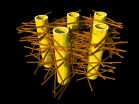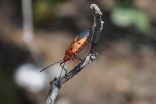(Press-News.org) Although the Universe may seem spacious most galaxies are clumped together in groups or clusters and a neighbour is never far away. But this galaxy, known as NGC 6503, has found itself in a lonely position, shown here at the edge of a strangely empty patch of space called the Local Void. This new NASA/ESA Hubble Space Telescope image shows a very rich set of colours, adding to the detail seen in previous images.
NGC 6503 is only some 18 million light-years away from us in the constellation of Draco (The Dragon), making it one of the closest neighbours from our Local Group. It spans some 30 000 light-years, about a third of the size of the Milky Way. The galaxy's lonely location led stargazer Stephen James O'Meara to dub it the "Lost-In-Space galaxy" in his 2007 book Hidden Treasures [1].
This galaxy does not just offer poetic inspiration; it is also the subject of ongoing research. The Hubble Legacy ExtraGalactic UV Survey (LEGUS) is exploring a sample of nearby galaxies, including NGC 6503, to study their shape, internal structure, and the properties and behaviour of their stars. This survey uses 154 orbits of time on Hubble; by contrast, a typical Hubble observing programme lasts from a few to a few tens of orbits.
The Local Void is a patch of space thought to be about 150 million light-years across that seems to be curiously devoid of galaxies. Astronomers using Hubble discovered that the emptiness of this region has quite an effect on the space around us -- the Milky Way is being strongly pulled away from it by the gentle but relentless tug of other nearby galaxies.
NGC 6503 lies right on the edge of this void. It has an almost non-existent central bulge surrounded by a massive halo of gas. The galaxy's central region is a good example of something known as a "low ionisation nuclear emission region", or LINER. These are less luminous than some of the brightest galaxies. Emission from NGC 6503's heart is believed to be the result of a starved black hole that is only just being kept active, receiving a very small amount of infalling gas to keep its large appetite at bay.
A previous image of NGC 6503 was released as a Hubble Picture of the Week back in 2010, taken by Hubble's Advanced Camera for Surveys. However, this new image, taken using Hubble's Wide Field Camera 3 (WFC3), shows NGC 6503 in striking detail and with a richer set of colours. Bright red patches of gas can be seen scattered through its swirling spiral arms, mixed with bright blue regions that contain newly-forming stars. Dark brown dust lanes snake across the galaxy's bright arms and centre, giving it a mottled appearance.
Installed in 2009 during the final Hubble servicing mission, SM4, WFC3 covers a wide range of the spectrum, from the ultraviolet all the way through to the near-infrared. Compared with its predecessor, the Wide Field and Planetary Camera 2 (WFPC2), it offers improved resolution and a wider field of view, and has led to a large number of stunning Hubble images since its installation.
INFORMATION:
Notes
[1] This was also the name of a Hubble image processing competition run in 2012, which invited people to scour the Hubble archive for interesting and beautiful observations.
Notes for editors
The Hubble Space Telescope is a project of international cooperation between ESA and NASA.
More information
NASA, ESA, D. Calzetti (University of Massachusetts, USA) and H. Ford (Johns Hopkins University, USA)
Links
Link to hubblesite release - http://hubbledev.stsci.edu/newscenter/archive/releases/2015/23/
Images of Hubble - http://www.spacetelescope.org/images/archive/category/spacecraft/
Hubblecast 40: Wide Field Camera 3 - Hubble's New Miracle Camera - http://www.spacetelescope.org/images/archive/category/spacecraft/
Candidate Active Nuclei in Late-type Spiral Galaxies - http://arxiv.org/pdf/0809.1443.pdf?origin=publication_detail
The stuffy noses and sinus pressure of head colds are uncomfortable, but for most people, they go away within days. For those with chronic sinusitis, however, those symptoms and others drag on for weeks. Now scientists are onto a potential new therapy that could address one of the underlying factors associated with the condition. They describe their work in the ACS journal Molecular Pharmaceutics.
In the body, nitric oxide (NO) plays a critical role in immunity. Researchers have found that this simple molecule is an important antimicrobial agent that helps prevent sinus ...
To some scientists studying climate change, boreal peatlands are considered a potential ticking time bomb. With huge stores of carbon in peat, the fear is that rising global temperatures could cause the release of massive amounts of CO2 from the peatlands into the atmosphere--essentially creating a greenhouse gas feedback loop.
A new study by researchers at the University of South Carolina and University of California Los Angeles challenges that notion, and demonstrates that the effect of temperature increases on peat storage could be minor.
Funded by the National ...
This news release is available in German.
Human teeth have to serve for a lifetime, despite being subjected to huge forces. But the high failure resistance of dentin in teeth is not fully understood. An interdisciplinary team led by scientists of Charite Universitaetsmedizin Berlin has now analyzed the complex structure of dentin. At the synchrotron sources BESSY II at HZB, Berlin, Germany, and the European Synchrotron Radiation Facility ESRF, Grenoble, France, they could reveal that the mineral particles are precompressed.
The internal stress works against crack ...
Chicago, June 10, 2015 - Patients diagnosed with an advanced form of metastatic non-small cell lung cancer (NSCLC) may benefit from surgical resection (removal of all or part of the lung) in combination with chemotherapy and radiation therapy, according to an article in the June 2015 issue of The Annals of Thoracic Surgery.
Key points
Patients diagnosed with stage IIIB NSCLC may benefit from multimodality treatment that combines surgical resection in combination with chemotherapy or radiation therapy.
Surgery should be added to the treatment regimen only for carefully ...
Dangerous heart rhythms called arrhythmias, often caused by undiagnosed heart conditions, can cause sudden cardiac arrests that take the lives of seemingly healthy young men and women including sports people.
A healthy, functioning heart has a regular electrical impulse that causes the heart to beat and pump blood around the body. If this impulse is interrupted or becomes irregular, it causes an abnormal heartbeat, called an arrhythmia. Arrhythmias can be a long-term condition, treated with medication or surgery or they can occur unexpectedly, suddenly stopping the heart ...
Europe's most homophobic countries may be paving the way for a rise in HIV cases among gay and bisexual men, according to new research published in the journal AIDS.
An international team of researchers from Europe and the US looked at HIV-related service use, need and behaviours among 175,000 gay or bisexual men living in 38 European countries with differing levels of national homophobia.
They found that men in homophobic countries had fewer sexual partners and were less likely to be diagnosed with HIV. However, they also found those men knew less about HIV, were less ...
This news release is available in German.
Insects are the most diverse animal group on earth. Many of them feed on plants, and they are constantly challenged by the diverse direct and indirect defenses of their food plants as well as an imbalanced nutrient composition. In response, the insects are continuously evolving different behavioral, morphological and biochemical adaptations to overcome the plant defenses. Additionally, some species rely on symbiotic microbes to deal with the plants' nutritional challenges. Scientists of the Max Planck Research Group ...
Rome, Italy, 10 June 2015: The results of the tREACH trial presented today at the European League Against Rheumatism Annual Congress (EULAR 2015) Press Conference showed that initial therapy with combination DMARDs significantly improves measures of disease activity and functional ability in patients with early rheumatoid arthritis (RA). These findings suggest that an initial treatment regimen of methotrexate, sulfasalazine and hydroxychloroquine could provide significant patient benefits over monotherapy (methotrexate alone).
"Many trials have shown that early and intensive ...
Rome, Italy, 10 June 2015: The results of a study presented today at the European League Against Rheumatism Annual Congress (EULAR 2015) Press Conference showed that ultrasound diagnosis of tenosynovitis (inflammation of the tendon sheath) was superior to clinical symptoms and signs in the prediction of early Rheumatoid Arthritis (RA). This is the first study to show that ultrasound-defined tenosynovitis is a strong predictor of early RA. By identifying the need for treatment before the onset of symptoms and signs, this procedure has the potential to improve clinical outcomes. ...
Washington D.C., June 10, 2015 - A recent study published in the July 2015 issue of the Journal of the American Academy of Child and Adolescent Psychiatry demonstrates that early intervention, beginning between 18 and 30 months of age improves outcomes for children with autism spectrum disorder (ASD) at age 6.
Early intensive behavioral intervention is recognized an as efficacious approach for improving outcomes for young children with ASD. However, most studies of comprehensive, intensive intervention only report immediate outcomes at the end of intervention and the ...


